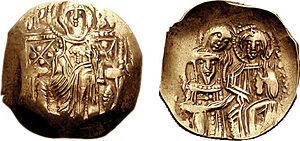Empire of Nicaea
|
|||||||||||||||||||||||||||||||||||
The Empire of Nicaea (Greek: Βασίλειον τῆς Νίκαιας, Turkish: İznik İmparatorluğu) was the largest of the Byzantine Greek states founded by the nobility of the Byzantine Empire after Constantinople was conquered during the Fourth Crusade. It lasted from 1204 to 1261.
Contents |
Foundation
In 1204, Byzantine emperor Alexius V Ducas Murtzouphlos fled Constantinople after French crusaders invaded the city. Theodore I Lascaris, the son-in-law of Emperor Alexius III Angelus, was proclaimed emperor, but he too fled, to the city of Nicaea in Bithynia, realizing the situation in Constantinople was hopeless.
The Latin Empire, which was established by the Crusaders in Constantinople, had poor control over former Byzantine territory, and Byzantine successor states sprang up in Epirus and Trebizond as well as Nicaea. Nicaea, however, was the closest to the Latin Empire and was in the best position to attempt to re-establish the Byzantine Empire. Theodore Lascaris was not immediately successful, as he was defeated at Poemanenum and Prusa (now Bursa) in 1204, but he was able to capture much of northwestern Anatolia after the Latin Emperor Baldwin I had to defend against invasions from Kaloyan of Bulgaria. Theodore also defeated an army from Trebizond, as well as other minor rivals, leaving him in charge of the most powerful of the successor states. In 1206, Theodore proclaimed himself emperor at Nicaea.
Numerous truces and alliances were formed and broken over the next few years, as the Byzantine successor states, the Latin Empire, the Bulgarians, and the Seljuks of Iconium (whose territory also bordered Nicaea) fought each other. Theodore tried to validate his claim by naming a new Patriarch of Constantinople in Nicaea. In 1219, he married the daughter of Latin Empress Yolanda of Flanders, but he died in 1222 and was succeeded by his son-in-law John III Ducas Vatatzes.
Expansion
In 1224, the Latin Kingdom of Thessalonica was captured by the Despot of Epirus, but Epirus itself came under Bulgarian control in 1230. With Trebizond lacking any real power, Nicaea was the only Byzantine state left, and John III expanded his territory into the Aegean Sea. In 1235, he allied with Ivan Asen II of Bulgaria, allowing him to extend his influence over Thessalonica and Epirus. In 1242, the Mongols invaded Seljuk territory to the east of Nicaea, and although John III was worried they might attack him next, they ended up eliminating the Seljuk threat to Nicaea. In 1245, John allied with the Holy Roman Empire by marrying Constance II of Hohenstaufen, daughter of Frederick II. By 1248, John had defeated the Bulgarians and surrounded the Latin Empire. He continued to take land from the Latins until his death in 1254.
Theodore II Lascaris, John III’s son, faced invasions from the Bulgarians in Thrace, but successfully defended the territory. Epirus also revolted and allied with Manfred of Sicily, and Theodore II died in 1258. John IV Lascaris succeeded him, but as he was still a child he was under the regency of the general Michael Palaeologus. Michael proclaimed himself co-emperor (as Michael VIII) in 1259, and soon defeated a combined invasion by Manfred, the Despot of Epirus, and the Latin Prince of Achaea at the Battle of Pelagonia.
Recapture of Constantinople

In 1260, Michael began the assault on Constantinople itself, which his predecessors had been unable to do. He allied with Genoa, and his general Alexios Strategopoulos spent months observing Constantinople in order to plan his attack. In July of 1261, as most of the Latin army was fighting elsewhere, Alexius was able to convince the guards to open the gates of the city. Once inside he burned the Venetian quarter (as Venice was an enemy of Genoa, and had been largely responsible for the capture of the city in 1204). Michael was recognized as emperor a few weeks later, restoring the Byzantine Empire. Achaea was soon recaptured, but Trebizond and Epirus remained independent Byzantine Greek states. The restored empire also faced a new threat from the Ottoman Empire, when it arose to replace the defeated Seljuks.
Military
The Nicaean Empire consisted of Byzantium's most highly populated Greek region, with the exception of Thrace which was under Latin/Bulgar control. As such, the Empire was able to raise a reasonably numerous military force of around 20,000 soldiers at its height - numbers recorded as participating in its numerous wars against the Crusader states. The Nicaeans continued some aspects of the Komnenian army, but without the resources available to the Komnenian emperors the Nicaean Byzantines could not match the numbers, nor the quality, of the armies that the emperor Manuel and his predecessors had fielded. Western Asia Minor had access to the sea, making it wealthier than most of the splinter states around and in time became the most powerful state in the region, if only for a short duration.
Emperors of Nicaea
- Theodore I Lascaris (1204-1222)
- John III Ducas Vatatzes (1222-1254)
- Theodore II Lascaris (1254-1258)
- John IV Lascaris (1258-1261)
- Michael VIII Palaeologus (co-emperor 1259-1261; restored Byzantine Empire)
